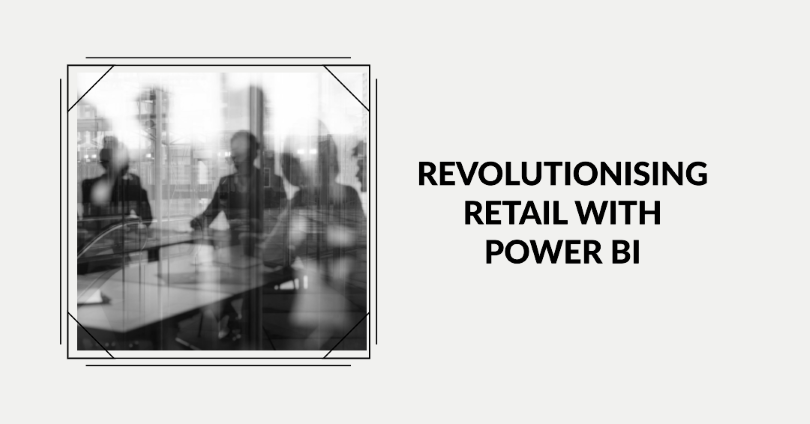
30 June 2023
Data has swiftly grown into one of the most valued assets in the business realm. This rings particularly true in the retail sector, where every bit of information can be the key to understanding customer behaviour, predicting market trends, and driving sales. That's where Power BI Retail comes into the picture, revolutionising the way retail businesses utilise data.
Power BI is a business analytics tool that enables organisations to visualise their data and share insights across the organisation. The tool helps to connect to hundreds of data sources and bring the data to life through live dashboards and reports.
Retail, an industry driven by customer patterns and preferences, can immensely benefit from this data-driven tool. Power BI Retail features allow businesses to make better-informed decisions and streamline operations in real time, thus revolutionising the retail sector.
To appreciate how Power BI revolutionises retail, we must first delve into its key features.
Now, let's delve deeper into these features and see how they directly influence the retail industry.
In the fast-paced world of retail, having the latest information at your fingertips is crucial. So, what is real-time analytics, and why is it vital in retail? Power BI has also helped government decision making too.
Real-time analytics in Power BI allows for live data updates, facilitating immediate and effective decision-making. It helps track inventory, monitor sales performance, and gauge customer preferences in real-time, enhancing the overall efficiency of retail operations.
User Case Example: A supermarket chain using Power BI can track sales data across all its stores in real time. This enables the management to understand which products are selling faster, identify peak sales hours, and make decisions about restocking or promotions instantly.
Visualising data can significantly simplify the process of understanding and analysing complex data sets. Power BI's interactive dashboards and reports transform raw data into visual insights, making it easier for retailers to identify trends and patterns.
User Case Example: A fashion retailer can use Power BI's interactive dashboards to visualise and compare the performance of various clothing lines over time. This visual representation can help them identify what's popular and what's not, aiding in decision-making for future clothing designs.
Data integration is the process of combining data from different sources into a unified view. Power BI's ability to connect with numerous data sources can provide a comprehensive picture of a retail business. The healthcare sector is also an advocate for using Power BI integration.
User Case Example: An online retailer can use Power BI to integrate data from its website, social media channels, and customer service platform. This unified data view can give a holistic picture of customer behaviour, preferences, and feedback, allowing the retailer to enhance customer experience.
AI-Powered predictive analysis uses machine learning to predict future trends based on past data. It provides foresight that can help retailers plan for the future.
User Case Example: An electronics retailer can use this feature to forecast future sales based on historical sales data. This insight can help them manage inventory better, plan marketing campaigns, and set sales targets.
In this digital era, mobility is crucial. Power BI provides mobile access to data, ensuring that retail managers and decision-makers can access data whenever they need it, regardless of their location.
User Case Example: A retail chain manager on a business trip can still monitor store performance using Power BI's mobile app. This ensures timely decisions and constant awareness of the business performance.
Let's explore some case studies that demonstrate the transformative power of Power BI in retail.
XYZ Retail, a large retail chain, was grappling with overstocking and stock-outs. They implemented Power BI to track and analyse their inventory data in real time. This enabled them to optimise their inventory levels, reducing overstocking by 30% and almost completely eliminating stock-outs.
ABC Fashion, an online fashion store, wanted to improve its customer experience. They used Power BI to integrate data from their website, social media, and customer service platforms. The insights derived helped them understand their customers better and tailor their offerings, resulting in a 25% increase in customer satisfaction scores.
123 Electronics, a global electronics retailer, was seeking ways to streamline its operations. They used Power BI's AI-powered predictive analysis to forecast sales and plan their inventory and marketing campaigns. This strategic foresight led to a 15% increase in sales and a 20% reduction in operational costs.
Power BI Retail is an invaluable tool that is redefining the way retail businesses operate. With features like real-time analytics, interactive dashboards, data integration, AI-powered predictive analysis, and mobile accessibility, Power BI is truly revolutionising retail.
In an era where data is king, leveraging Power BI can provide retail businesses with the edge they need to thrive in a competitive market. The future of retail lies in data, and Power BI is leading the way.
1. How does real-time analytics in Power BI benefit retail businesses?
Real-time analytics allows for live data updates, enabling immediate and effective decision-making in retail businesses.
2. Can Power BI integrate data from multiple sources?
Yes, Power BI can integrate data from numerous sources, providing a comprehensive view of the business.
3. What is AI-powered predictive analysis in Power BI?
AI-powered predictive analysis uses machine learning to predict future trends based on past data. This provides foresight, helping retailers plan for the future.
4. Is Power BI accessible on mobile devices?
Yes, Power BI offers mobile apps that allow access to data anytime, anywhere.

CONTACT
+44 (0)20 8446 7555
Copyright © 2025 JBI Training. All Rights Reserved.
JB International Training Ltd - Company Registration Number: 08458005
Registered Address: Wohl Enterprise Hub, 2B Redbourne Avenue, London, N3 2BS
Modern Slavery Statement & Corporate Policies | Terms & Conditions | Contact Us
POPULAR
AI training courses CoPilot training course
Threat modelling training course Python for data analysts training course
Power BI training course Machine Learning training course
Spring Boot Microservices training course Terraform training course